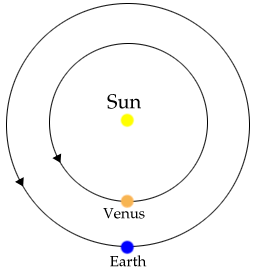Venus
Venus was the astronomical object of greatest interest. I think it possible that the Maya knew it better than any civilization outside Mesoamerica. They thought it was more important than the Sun. They watched it carefully as it moved through its stations--it takes 584 days for Venus and the Earth to line up in their previous position as compared to the Sun. It takes about 2922 days for the Earth, Venus, the Sun, and the stars to agree.
 The pattern of Venus is
usually reckoned at Inferior Conjunction, that time when
Venus passes between the Sun and the Earth.
A diagram of this situation can be seen on the left.
The pattern of Venus is
usually reckoned at Inferior Conjunction, that time when
Venus passes between the Sun and the Earth.
A diagram of this situation can be seen on the left.
During this period, Venus cannot be seen from Earth. It disappears for a short period that averages 8 days. When it first rises after inferior conjunction, that is when it was first spotted in the morning sky, called heliacal rising because it is rising with the sun, was the most important position of Venus.
After rising, Venus will reach its greatest brilliancy then it greatest elongation west, moving quickly (in retrograde motion) away from the Sun. After that it will remain visible for about 260 days in the morning sky until it reaches superior conjunction. At this point Venus is on the opposite side of the Sun as we view it from Earth. It becomes dim, until it dips back under the horizon, only to appear on the opposite side of the sun an average of 50 days later. It then rises as a evening star and remain in the night sky about 260 days until it goes through its eastern elongation point and greatest brilliancy before arriving at Inferior Conjunction again.
The Maya made daytime observations of Venus. Venus had a psychological effect upon the Maya and other Mesoamerican cultures, it has been shown that the Maya were timing some of their wars based on the stationary points of Venus and Jupiter. Humans were sacrificed on first appearance after Superior Conjunction when Venus was at its dimmest magnitude but they most feared the first Heliacal Rising after Inferior Conjunction.
In the Dresden Codex, the Maya had an almanac that displayed the full cycle of Venus. They counted five sets of 584 days, that is 2,920 days is approximately 8 years or 5 repetitions of the Venus cycle.